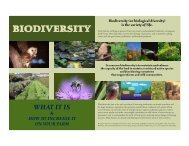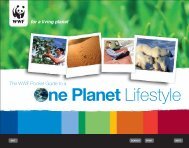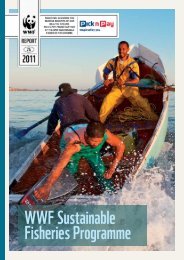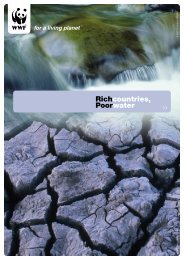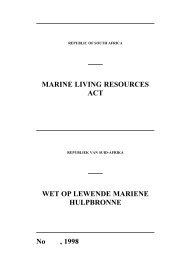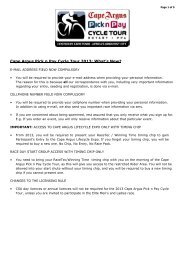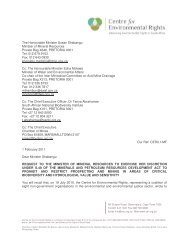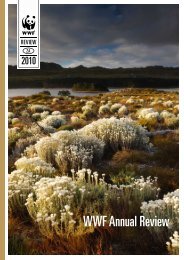State of Management of South Africaââ¬â¢s ... - WWF South Africa
State of Management of South Africaââ¬â¢s ... - WWF South Africa
State of Management of South Africaââ¬â¢s ... - WWF South Africa
- No tags were found...
Create successful ePaper yourself
Turn your PDF publications into a flip-book with our unique Google optimized e-Paper software.
STATE OF MANAGEMENT OF SOUTH AFRICA’S MARINE PROTECTED AREASMONITORING (71%)There was some monitoring occurring in the MPA but no overall strategy for adaptivemanagement has been employed. The monitoring is focussed on abalone, key fish speciesand the birds on the islands. SAEON (<strong>South</strong> <strong>Africa</strong>n Environmental Observer Network) isdeveloping a scientific data base for marine living resources in the MPA. Thresholds <strong>of</strong>Potential Concerns had been assigned to the MPA and there was a monitoring system inplace to evaluate these. Independent consultants identified research needs for the MPA andsupport was provided to students to work on management driven projects. The research wasnot comprehensive and had been mandated specifically for abalone.PUBLIC EDUCATION AND AWARENESS (33%)There was a planned education programme based in Addo Elephant National Park. Theeducation programme targeted children and incorporates the Kids in Parks Programme,Imbewu camping trips, EnviroKid books and competitions, day trips to the National Park andvisits to schools. There was no programme specific to the MPA; however SANParksarranged school group visits to Bird Island during marine week and arranged buses totransport the group (reaching approximately 600 children). There was no adult education forstakeholders and the public in the area and there were no brochures for the MPA. There wasonly one MPA sign board near the slipway at the harbour in Port ElizabethINTERACTION WITH STAKEHOLDERS AND COMMUNITIES (91%)There was a communication program being implemented through the Park Forum to buildsupport for the MPA amongst relevant stakeholders. Information exchange from SANParksstaff to stakeholders was effective for the most part but there was still a distrust <strong>of</strong> theinformation provided by the community. Stakeholders were consulted at regular intervals andmajor stakeholders such as commercial fishermen, angling clubs and ski boat clubsconsistently participated. All comments made in the meetings were responded to and extrainformation was usually provided to those making the comments so to attempt to buildsupport for conservation.There were two forums which facilitated interaction between local communities (around theWoody Cape section) and SANParks staff, these were the Park Forum and the MayibuyeNdlovu Development Trust on which representatives from eight local communities, localgovernment, Sundays River Tourism Forum and SANParks sat. Despite these efforts thecommunities in the Woody Cape area harboured much animosity towards the SANParksstaff. Poaching <strong>of</strong> abalone was accepted by most <strong>of</strong> the communities in the area and manyallegedly supported and assisted poaching operations. There was little understanding <strong>of</strong>SANParks role and function in the MPA and it was reported that many threats had beenmade against staff.Pg 70



